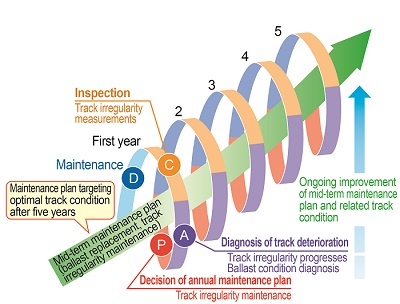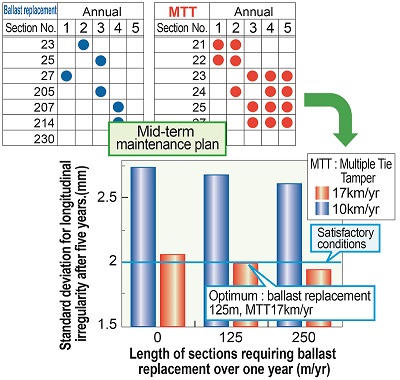15. Decision making system for economical mid-term track maintenance plans
In order for track maintenance and management to be more efficient, it is important to make the, “inspection, diagnosis (level of deterioration), maintenance plan preparation, maintenance implementation” cycle as functionally efficient as possible. Consequently, discussions began on how to effectively exploit track irregularity data etc. collected by either track inspection cars or commercial trains in order to develop a system that would propose maintenance plans for short to medium and long term periods.
As a result, a medium term maintenance planning system was developed to plan both ballast replacement and maintenance for track irregularity for 5-year periods.
Figure 1 shows how a yearly maintenance planning system functions according to the 5-year maintenance plan decided by this system, upgrading track maintenance and management more efficient.
In the developed medium-term maintenance planning system, the state of deterioration of the track is diagnosed on the basis of past maintenance and track irregularity data, from which sections of ballast that require replacement are extracted. Ballast replacement prioritization is calculated on the basis of savings to be made on the cost of track irregularity maintenance by replacing the ballast.
If the maximum possible maintenance for each year for ballast replacement and track irregularity maintenance is attributed, then the plan decided by this system will ensure that the track is in best condition after five years (annual ballast replacement and track irregularity maintenance). Then, since the relationship between the amount of maintenance and track condition can be analyzed (Fig. 2), it is possible to decide the maintenance plan to maintain the track to a satisfactory level at a lower cost. Apart from determining the sections requiring maintenance to manage track irregularities over a year, use of the collected data allows the plan to be reviewed etc., and can be connected to the newly developed management and maintenance planning system to update annual plans, in order to continuously improve the efficiency of the management cycle.
The new system was introduced into the track maintenance planning systems being developed by railway operators, and brought into service in 2018.
Other Contents
- 12. Development of early restoration and reinforcement technologies for embankments damaged by natural disasters
- 13. Tunnel reinforcement method using improved performance ground reinforcement rock bolts
- 14. Simple catenary designed for running speeds of over 300km/h
- 15. Decision making system for economical mid-term track maintenance plans
- 16. Rail head defect repair method with reduced work time
- 17. Wireless train control systems designed for regional railways
- 18. Concrete deterioration control using hydrogen-ion type geopolymer
- 12. Development of early restoration and reinforcement technologies for embankments damaged by natural disasters
- 13. Tunnel reinforcement method using improved performance ground reinforcement rock bolts
- 14. Simple catenary designed for running speeds of over 300km/h
- 15. Decision making system for economical mid-term track maintenance plans
- 16. Rail head defect repair method with reduced work time
- 17. Wireless train control systems designed for regional railways
- 18. Concrete deterioration control using hydrogen-ion type geopolymer


